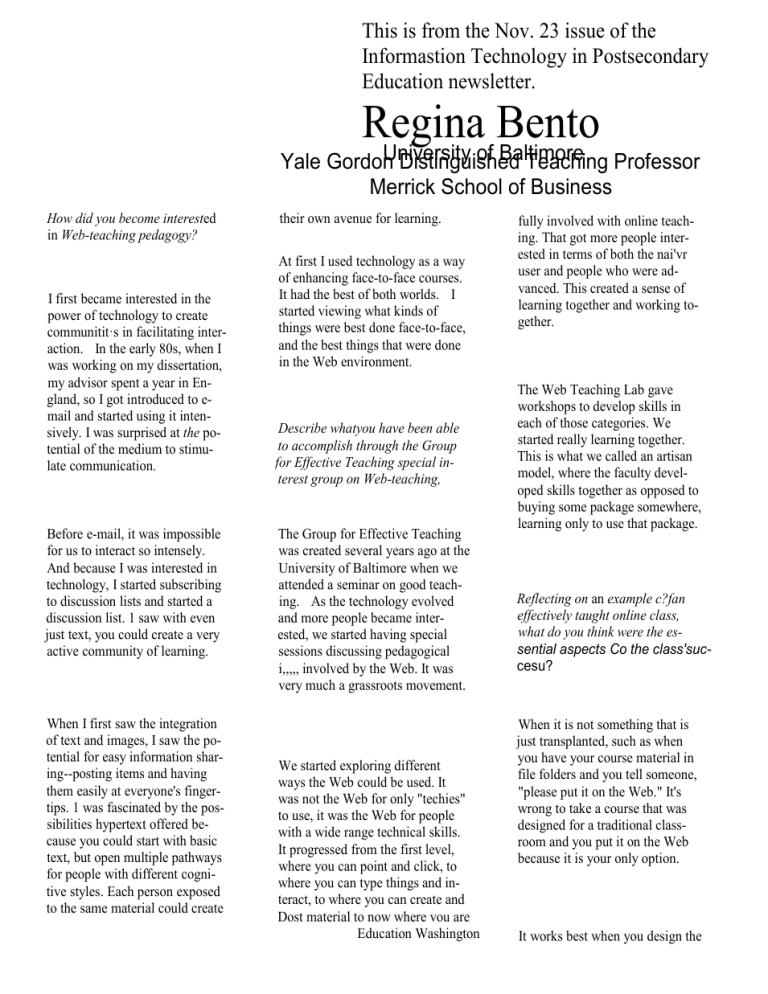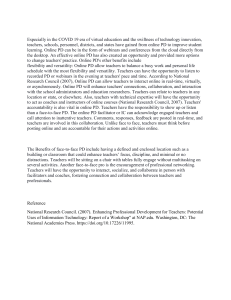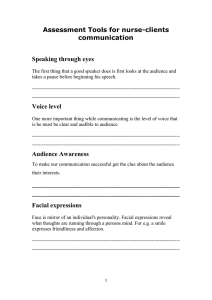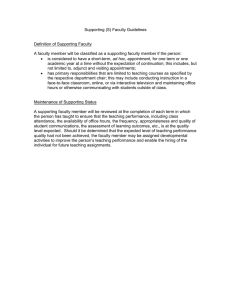testtw~1.doc
advertisement

This is from the Nov. 23 issue of the Informastion Technology in Postsecondary Education newsletter. Regina Bento University of Baltimore Yale Gordon Distinguished Teaching Professor Merrick School of Business How did you become interested in Web-teaching pedagogy? I first became interested in the power of technology to create communitit·s in facilitating interaction. In the early 80s, when I was working on my dissertation, my advisor spent a year in England, so I got introduced to email and started using it intensively. I was surprised at the potential of the medium to stimulate communication. Before e-mail, it was impossible for us to interact so intensely. And because I was interested in technology, I started subscribing to discussion lists and started a discussion list. 1 saw with even just text, you could create a very active community of learning. When I first saw the integration of text and images, I saw the potential for easy information sharing--posting items and having them easily at everyone's fingertips. 1 was fascinated by the possibilities hypertext offered because you could start with basic text, but open multiple pathways for people with different cognitive styles. Each person exposed to the same material could create their own avenue for learning. At first I used technology as a way of enhancing face-to-face courses. It had the best of both worlds. I started viewing what kinds of things were best done face-to-face, and the best things that were done in the Web environment. Describe whatyou have been able to accomplish through the Group for Effective Teaching special interest group on Web-teaching, The Group for Effective Teaching was created several years ago at the University of Baltimore when we attended a seminar on good teaching. As the technology evolved and more people became interested, we started having special sessions discussing pedagogical i,,,,, involved by the Web. It was very much a grassroots movement. We started exploring different ways the Web could be used. It was not the Web for only "techies" to use, it was the Web for people with a wide range technical skills. It progressed from the first level, where you can point and click, to where you can type things and interact, to where you can create and Dost material to now where vou are Education Washington fully involved with online teaching. That got more people interested in terms of both the nai'vr user and people who were advanced. This created a sense of learning together and working together. The Web Teaching Lab gave workshops to develop skills in each of those categories. We started really learning together. This is what we called an artisan model, where the faculty developed skills together as opposed to buying some package somewhere, learning only to use that package. Reflecting on an example c?fan effectively taught online class, what do you think were the essential aspects Co the class'succesu? When it is not something that is just transplanted, such as when you have your course material in file folders and you tell someone, "please put it on the Web." It's wrong to take a course that was designed for a traditional classroom and you put it on the Web because it is your only option. It works best when you design the example, thlnfe of when word processing started. People started using word prclcessing much the same way they would use their typewriter. They would do the text by hand and afterwards they would type on the computer, which would sometimes fail. Then as people learned more and more about word processing, it changed the way they wrote. When I write long hand now, I think in terms of cut and paste and moving things around. I think differently. I think that's the initial step that has to happen. You start thinking differently, you take on a different frame of mind. Web teaching changes the way you teach face-to-face, the same way word processing changes the way you write and communicate. Regardless of the medium you are using--whether it be face-to-face or electronic--you have to have those two components as opposed to just regurgitating material. What are some challenges and disadvorrlages you lurveformd ir~ using the Web for teaching [ absolutely love the mixed model. I don't see any drawbacks. In between classes, we interact on a discussion board. This is wonderful because we discuss the topic of the week before we ever get to class. When we arrive to class, we are in the middle of a conversation rather than starting a topic. We arrive to class dying to get together. People arrive early to class mey continue me mscusslon. I find some of the heaviest contributors to the online discussion are the students who are shy in the face-to-face environment. It provides opportunities for students with different cognitive styles to be involved. Web teaching changes the way you teach face-to-face, the same way word processing changes the way you write and communicate. I feel classes taught exclusively online need to meet sometime-not in terms of transfer of knowledge, but in emotional terms. One day at least. We considered using NetMeeting so we could at least see each other. The other challenge is online courses become a 24-houra-day, seven-day-a-weekinvolvement. I was continuously thinking about it and feeling as if there was an umbilical cord between the computer and me. What are some major di~gerences between teaching online nnd traditional classroom teaching? It's funny because the differences are becoming blurred. Even when I am in an environment where I do not have a computer, the Web has changed my view on what materials I can have for the class. I teach a class at another school in the even then, the wep nas cnangea my outlook on teaching. At the University of Baltimore 1 have a high-tech, high-touch approach to my traditional students, where we still meet face-to-face, but you have to interact so actively before and after class. What needs to happen for online learning to evolve and eventually become widely acccptedas a viable source ofeducnrion? We need to reach a certain level of people who will not look at online learning as a second choice, an also ran. We can see an example of this with what is happening to electronic media, if you look at newspapers and TV broadcasts. Just a few years ago, people were wondering what would be the role of newspapers and TV and how their content would differ with the advent of the Internet. Now the different medias complement each other. Newspapers rely on the Web a lot due to time and space constraints. For education to get to this point, we need to learn more about course design and make pedagogical considerations. We cannotjust go to an old file cabinet, grab some folders, dump it onto a programmer's desk and say, "please put this on the Web." You cannotjustlamentoverwhatyou don't have with this new medium. We need to celebrate over the new things we can do that we couldn't do before. Inteniew b~' J~mnrhan Baglqv n~uinhp~ Erll Ir~tinn W~~hinnt~n





